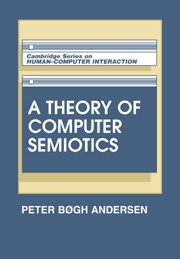 A Theory of Computer Semiotics
A Theory of Computer Semiotics Introduction
Published online by Cambridge University Press: 26 March 2010
Summary
The first part of the book ended with a sketch of the computer system as a medium, and the purpose of this second part is to turn this sketch into a more detailed portrait. What are important properties of computer systems from this perspective, and how should systems be structured?
It should come as no surprise that the interface, defined in Section 1.2.3.3 as a collection of computer-based signs, and its functions relative to the linguistic environment and working context reign supreme in this approach. The basic function of a system is to generate processes in which an interface can be expressed, just as the only reason for having the costumes and wings in a theater is the experience they may contribute to giving the audience. Although this view on design is relatively new in computer science, it exists under the name of user centered design.
This view makes it difficult to maintain the tradition of separating functionality from the interface. Traditionally, functionality is what can be done with the system, while the interface is the manner in which it is done. Thus, two word processors have different functionality if one allows the user to make an automatic table of contents while the other does not. They have the same interface if operations are done in the same way, for example if text is selected by dragging the mouse over the desired piece of text, whereas their interface is different if one uses the mouse while the other requires the user to type line and character numbers in to select text.
- Type
- Chapter
- Information
- A Theory of Computer SemioticsSemiotic Approaches to Construction and Assessment of Computer Systems, pp. 190 - 192Publisher: Cambridge University PressPrint publication year: 1991


